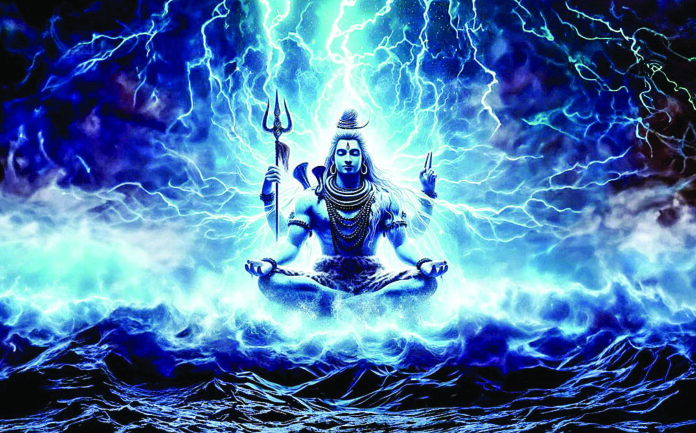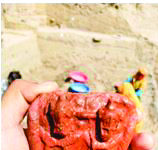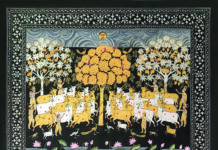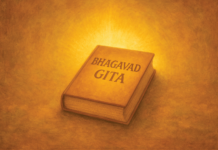Lord Shiva symbolizes pure energy, innocence, and divine unity, embracing body, spirit, and cosmic transformation.
Very much like human beings, Divinities as well as their abodes of worship have
“good times as well as bad times “. Parabrahmam, the Absolute, which has no attributes, no need for worship to exist, and is complete in Itself is far beyond Space and Time. This is for lack of a better word, pure Shakthi or Energy. Every Deity is a particular combination of qualities taken from within this Parabrahmam. As human beings, it is difficult for us to grasp the colossal Truth of Parabrahmam. Rather like a complicated mathematical equation being broken down to easy steps, we are able to deal with such a Force only bit by bit. The entire aim of our ancient Sanatana Dharma is to merge back into the very Divinity which created us. Paulo Coelho’s work “The Alchemist “ is a fairly recent Western work which shows this with utter simplicity.
That the way to Divinity is extremely simple is a Truth. The catch is that it is very difficult to be that simple! Shiva, one of the most powerful Gods of the Sanatana Dharma Trinity, embodies this. One of His names is “ Bhola “ or the Innocent One and no other Divinity comes anywhere near Shiva in this.
There are so many stories about Shiva. Contrary to a recent contempt for mythology, all religions are enriched by the stories associated with them. It is not possible to imagine Christianity without the Bible. Any Faith without it’s particular collection of parables, fables etc would end up being a dry collection of theories of least interest except to academicians.
One of the greatest and most unique contributions of our Sanatana Dharma to World philosophy is the concept where physical love is seen as a path to union with the Divine. There is absolutely no sense of shame for the human body. Temples are centres of Worship for Sanatana Dharma. Those ancient carvings have graphic depictions of the human body engaged in pleasuring itself as well as giving pleasure.
Lord Krishna’s Raas Leela in the fulfilment of this. Moralists have fallen into the sad trap of claiming that it was ”beyond” physical. As if I did not write this physically and you read this physically as well!
It is a way to gain control of other human beings to tell them, no to try and convince them, that their body is a different and often antithetical entity to their spirit. The body is unclean and must be dumped to reach spiritual heights.
On the contrary we have poojas celebrating Divinity where every sense is heightened and elated. The visuals of a beautifully arranged venue with brilliant silks and flowers, the fragrance of incense, the sweet sound of manthras (incantations) from hundreds of throats, the ubiquitous Fire, the Deity who accepts all human offering and conveys it to Godly realms, the multi-flavoured delicious Naivedyam that have kids ( and adults ) salivating are all part of the pageant and infinite richness of worship. In fact the Gods would find it hard to stay away from such a site!
Shiva, the Deity pleased with just a tumbler of water poured on His head takes on very interesting forms throughout our country. Two of the most interesting Avatars (incarnations) are that of Muththappan (literally grandfather), prevalent in Kannur, one of the Northern Districts of Kerala. Muththappan stands every preconceived postulate about Sanatana Dharma on its head. Muththappan›s vehicle is a dog and dogs are worshipped in Muththappan›s temples throughout. He is celebrated with Vellaattam, where there is the loud and insistent beat of the Chenda (drum), an instrument best enjoyed in the open air. His prasadam is chana, «kadala», often with a piece of coconut and hot sweet tea. Everyone irrespective of social or economic standing sits on wooden benches and has this mandatory prasadam.
Clad in glorious red, with sandal paste all over His body, tribal anklets on His feet and white beard and with the elaborate headgear, Muththappan is ready to delight His devotees with His wisdom,.love and inclusivity. He is armed and sips country liquor as He solves each devotees› problems with surprising practicality and simplicity. Muththappan›s abodes are often simple whitewashed buildings in keeping with His utter simplicity. Muththappan›s Vellaattam is slowly going international with satsangs in USA, UK etc though the serenity of the waving coconut fronds and the gently flowing river right outside the Parassini Kadavu temple takes one to a different World.
Another equally fascinating Avatar of Shiva is at the Kottiyoor Vaishakha Mahotsava. This festival comes once a year and is closely associated with Shiva losing His first wife Sathi to Her father›s sacrificial fire. Daksha was a Prajapathi and the father of Sathi. He never quite approved of Sathi›s choice of husband. Full of himself, Daksha could never bring himself to see Shiva for what He really was. As far as Daksha was concerned Shiva was just an ordinary son-in-law who refused to get up and show Daksha the deference due to a wife›s father.
To insult Shiva, Daksha convened a yagna for which everyone except Sathi and Shiva were invited. Upon seeing so many entities head off to Her parental house, Sathi was insistent that She go to the yagya, albeit uninvited. Shiva was unhappy with this decision. But Sathi was adamant. When She reached the yagyashala, She was furious and heartbroken to see Daksha insult Shiva even further. No, She did not want that body which came out of a father who could not respect Shiva. She burned Herself up with the yoga agni lying dormant in each of us.
Shiva who has reluctantly sent off His wife to Her parental house got the news that She was a charred corpse. His anguish knew no boundaries. Hugging what was left of Sathi, Shiva danced His terrible dance of Destruction, the Samhara Thandava. It was Shri Maha Vishnu who came to save the World. Adroitly He cut off Sathi›s body with His Chakra. Each place on Earth where a piece of Her body fell, became a Shakthi Peetha.
In Kottiyoor temple there is something seen nowhere else on Earth. This is called Aalingana Pushpanjali, literally a hugging worship. The eldest priest of the temple literally lies down on Shiva, often for more than an hour. This denotes
Shri Maha Vishnu hugging a bereft Shiva to Himself, calming Him down. Nowhere else is the sense of touch celebrated to such an extent.
It is high time that we, who often sadly apologists for Sanatana Dharma, restore our knowledge of what is ours. We need to learn to lose our sense of shame for this body, a Divine gift from our Creator. Even if it takes us a Shri Maha Vishnu hugging a Shiva to do so.
* Thiruvathira Thirunal Lakshmi Bayi was born the XII Princess of the erstwhile royal family of Travancore.








